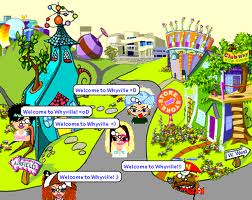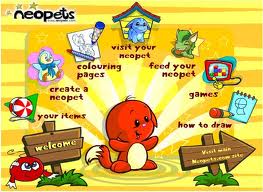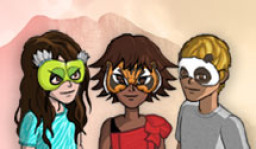Virtual worlds offer children an opportunity to create identities for themselves but increasingly they are being hijacked by commercial interests.
According to an estimate reported by the Independent newspaper, in 2008, there were "more than 100 youth-focused virtual worlds now either up and running or about to launch – over half of which are aimed at under-sevens".
 For example, Habbo Hotel is a website with a three dimensional chat environment and 2.9 million registered members. It targets 10 to 18 year olds. Players adopt the identity of an animated character – an avatar – and interact with each other in a virtual world. Marketers are able to put brands on virtual products in this environment so that players not only see them but interact with them.
For example, Habbo Hotel is a website with a three dimensional chat environment and 2.9 million registered members. It targets 10 to 18 year olds. Players adopt the identity of an animated character – an avatar – and interact with each other in a virtual world. Marketers are able to put brands on virtual products in this environment so that players not only see them but interact with them.
Habbo Hotel is one of several internet sites designed by Alloy Media & Marketing. Others include alloy.com and delias.com, both fashion websites targeting 12–24 year old females, and ccs.com, an action-sports website for 12–17 year old males. Alloy claims to have “1500 clients including half of the Fortune 200” and that its youth network reaches 8.2 million young people.
Virtual worlds are proliferating on the internet. Some virtual worlds are specifically designed to promote particular products such as Kellogg’s Go-Tart’s site and MyCoke.com. In others marketers create their own avatars to spread marketing messages. ‘Chatbots’ have been developed that utilise software to enable marketers to infiltrate and spread spam and advertising to chat sites and provide speech for marketer’s avatars in virtual worlds by responding to cue words used by those participating. Coca-Cola and Burger King are reported to be using chatbots.
 Whyville.net is one of the several virtual worlds that have been specifically designed for children. It claims to have millions of members and purports to offer education as well as entertainment, but it also sells marketers the opportunity for product placement: "The primary support for Whyville comes from its sponsors". Whyville has a newspaper, a beach, a museum, a town square, a City hall, games and activities, and an economy with its own currency.
Whyville.net is one of the several virtual worlds that have been specifically designed for children. It claims to have millions of members and purports to offer education as well as entertainment, but it also sells marketers the opportunity for product placement: "The primary support for Whyville comes from its sponsors". Whyville has a newspaper, a beach, a museum, a town square, a City hall, games and activities, and an economy with its own currency.
Webkinz is a virtual world aimed at little girls, where they can purchase a virtual pet and ca re for it, as well as virtual dolls for which they buy a range of products like lip gloss and body spritzes and thereby learn about adult products that they will buy for themselves when they grow up. Websites likeWebkinz that run virtual economies teach children to be consumers and portray the world as one where being a good citizen involves buying “the right stuff”.
re for it, as well as virtual dolls for which they buy a range of products like lip gloss and body spritzes and thereby learn about adult products that they will buy for themselves when they grow up. Websites likeWebkinz that run virtual economies teach children to be consumers and portray the world as one where being a good citizen involves buying “the right stuff”.
Neopets is another virtualworld, from Nickelodeon, targeted atchildren which has "immersive advertising", that is advertising that is integrated into the content of the site rather t han placed in banners or side panels. It was bought by media giant Viacom in 2005 for $160million because it was thought to be so lucrative.
han placed in banners or side panels. It was bought by media giant Viacom in 2005 for $160million because it was thought to be so lucrative.
Nickelodeon also launched a virtual world for children (6 to 14) in 2007 called Nicktropolis where they can create a three dimensional video version of themselves and design and fill virtual bedrooms with consumer items. They can go shopping in the virtual world as well as play games at a virtual amusement park. A Nickelodeon executive said: “We are workin g with our partners to figure out the most appropriate way to insert advertising into the site that will not take away from the user experience yet still provide marketers the most value". Nicktropolis has since been closed and replaced with The Club.
g with our partners to figure out the most appropriate way to insert advertising into the site that will not take away from the user experience yet still provide marketers the most value". Nicktropolis has since been closed and replaced with The Club.
Such sites enable children and teenagers to create a fantasy identity with invented physical features, immerse themselves in a branded world, and interact with branded products including dressing their avatar in branded clothes. This enables them to experiment with possible identities at a time when they are forming their own identity. The danger is that their personal identity is likely to become associated with and shaped by brands.
See also: Pester Power | Kidfluence | Brand Loyalty | Marketing Guns | Gathering Data | Girls Intelligence Agency | Cool Marketing | Viral Marketing | Underground Marketing | Social Media
See also:
Advertising to Children - Internet